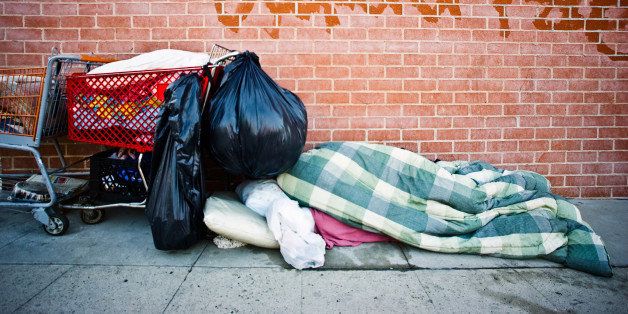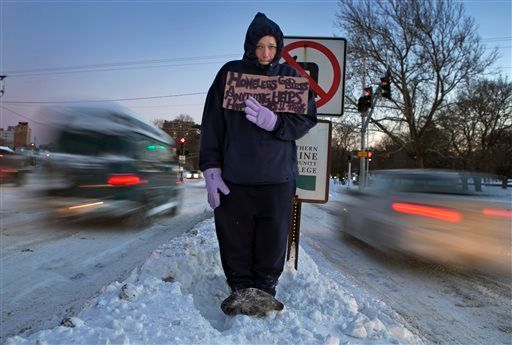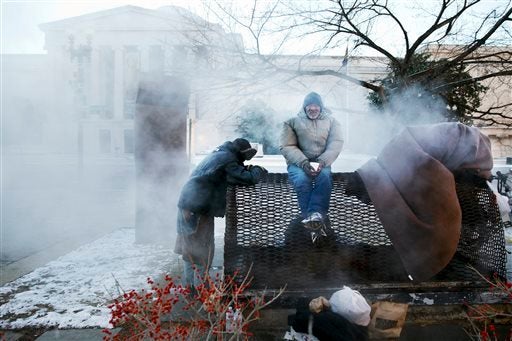
People across the country are rushing to shutter themselves indoors as meteorologists warn of a "life-threatening" deep freeze that has settled over the Midwest and is steadily headed southward and eastward.
In cities like Fargo, N.D. (with a forecast of 32 below zero) and Madison, Wis. (21 below) where dangerous, frigid temperatures are expected to last until at least Tuesday afternoon, conditions have been made even more severe by the glacial windchill. In Chicago, for instance, where it was reportedly colder at O'Hare International Airport than at the South Pole Monday morning, the wind chill dropped to 42 degrees below zero.
Meteorologists have warned that the below freezing temperatures, which will soon envelop parts of the East Coast as well, could cause frost bite "in minutes or even seconds."
Unfortunately, there may be some across the country who may not be able to seek shelter indoors to hide from the inclement weather in the coming days.
"According to the latest government data, more than 600,000 Americans are homeless on any given night," Think Progress wrote in a report Monday. "And the low-income individuals who live on the streets are particularly at risk during extreme weather events. Each year, about 700 homeless people die from hypothermia."
In the coming days, there will be many people across the country whose lives will be in danger as the bitter cold takes hold. But their well-being could be assured -- with your help.
"We're so accustomed to walking by the homeless without a second thought," Michael Stoops, the director of community organizing at the National Coalition for the Homeless, told The Huffington Post Monday. "But it's important for people to be looking out for other people. We should all make a point to do that, especially in the winter time."
It's everyone's responsibility, Stoops added, to see if that person huddled outside your office or your home or on the bus "needs help and if that person wants to go to a shelter."
Here are some ways you can help:

If, however, you don't have this information handy, or if you are unwilling, for whatever reason, to personally approach the person in question, then you should consider calling a local crisis hotline (Forbes has a partial list of numbers you could call) or 911.
(In the photo above, 28-year-old Victoria Morris is pictured panhandling in Portland, Maine, where the temperature at dusk was 7 degrees Fahrenheit on Friday. Morris, who is homeless, finally sought shelter when she could no longer feel her toes, the AP reports.)

But keep this in mind: Even if you have the best of intentions, Stoops recommends that you use tact when approaching someone who you think is homeless.
"There's a lot of shame involved in being homeless," he said, so avoid making assumptions or asking personal questions.
Instead, Stoops says that you should consider following these steps: "If I have a blanket or a pair of socks or something, what I'll generally do is I'll introduce myself before asking for their name. Then rather than ask if they're homeless, I'll ask them: 'Where did you sleep last night?' I'll then ask the person if he or someone he knows could use the blanket I have."
Even if you don't have an extra blanket on hand or warm clothing to spare, there's still something you can do. An act of kindness can lift spirits, Stoops says, and can be just as useful on a cold, dark night.
"Our homeless friends have told us that oftentimes, simple conversation or just being treated nicely, with dignity and respect, is as important as getting something tangible," he said.
(In the photo above, four homeless men are pictured warming themselves on a steam grate by the Federal Trade Commission, blocks from the Capitol, during frigid temperatures in Washington, Saturday, Jan. 4.)

"We shelter people when it gets really, really cold," Stoops said. "But it should be a year-round thing. I wish Americans would think of homeless people during the warmer months... We can lose as many people during the warmer months than the winter."
Some parts of the U.S. can get dangerously hot during the summer months, which can put vulnerable communities at considerable risk of a whole slew of heat-related health problems, including heat stroke and dehydration.
According to Stoops, volunteering also spikes during the holiday season and is not "consistent" through the year.
"Around Thanksgiving and Christmas, there are so many volunteers that sometimes we have to turn them away," Stoops said. "But if I ask them if I can sign them up for a shift in the soup kitchen on Feb. 15 or Aug. 1, they get very quiet. Very few people can think about homelessness throughout the year but I'd encourage people to be consistent and to volunteer on a regular basis."
Experts say that while short-term help is crucial and cannot be overlooked, fighting homelessness is a long-term process.
"Giving out blankets and sandwiches" is great, Stoops said, but to tackle homelessness in a holistic way, we also need to think about "attacking the root causes of poverty."
For instance, "we need to focus…on increasing minimum wage, making housing affordable, improving health care and pushing public officials and religious leaders to tackle inequality and poverty," he said.
(In the Nov. 20, 2013, photo above, homeless Korean War veteran Thomas Moore, 79, left, speaks with Boston Health Care for the Homeless street team outreach coordinator Romeena Lee on a sidewalk in Boston.)
For more information on how to help the homeless, check out this national directory of homeless shelters, as well as the website of the National Coalition for the Homeless.

